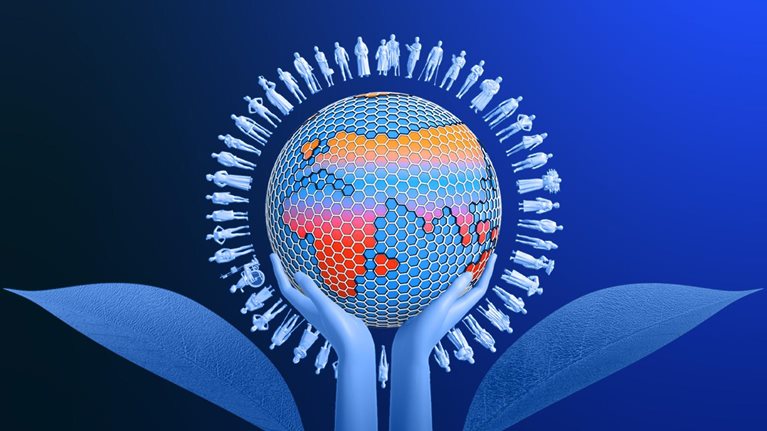Just when we need cooperation the most, the world order appears to be fragmenting. Seven hundred million people still live in extreme poverty, and four billion more are not fully economically empowered.1 Continued rising global emissions highlight the urgency of addressing climate challenges and the energy transition.2 We are also seeing the highest number of forcibly displaced people in a generation, and our once-stable global system is experiencing rising geopolitical, geo-economic, and market uncertainty.3
But is that picture fully accurate? In partnership with the World Economic Forum (WEF), we have developed a Global Cooperation Barometer that can help leaders understand and act on broad global trends that have a direct impact on the lives and livelihoods of billions of people. The barometer takes the pulse of five pillars of global cooperation—trade and capital flows, innovation and technology, climate and natural capital, health and wellness, and peace and security (see sidebar “About the Global Cooperation Barometer”). The full report is available online; what follows is a synthesis of its major points. (For a complete list of sources from the full report, see sidebar “Appendix.”)
The world is at an inflection point. The barometer indicates that global cooperation has stalled, after trending positively for much of the past decade (Exhibit 1).

This story varies by pillar—in some pillars, cooperation has been rising; in others, it has started to reverse (Exhibit 2):
- Trade and capital cooperation grew through the pandemic disruption but slowed in 2023. Geopolitical tensions and new restrictions make the future path unclear.
- In innovation and technology, flows of data, intellectual property (IP), and international students powered advances until 2020, but new questions have arisen about how to work together to harness the opportunities.
- Powered by financing commitments, climate and natural capital have increased steadily—but emissions continue to rise, and it is now time for action.
- Cooperation in health and wellness accelerated markedly in response to the pandemic but appears to be reverting back to a lower level consistent with prior trends.
- Peace and security have been in steady decline since 2016, with a marked acceleration in negative trends over the past few years.

As of the latest available data, no metric has yet seen unrecoverable deterioration; action to restore the 2012–20 trend is still possible and essential if we are to respond effectively to our collective challenges, which are many. Global trade and capital flows have played a central role in bringing the world closer and raising global living standards, but the job is far from over.4 Technological innovation is key to boosting sluggish productivity growth, and generative AI (gen AI) offers extraordinary possibilities, with the potential to add $2.6 trillion to $4.4 trillion in additional annual value.5 Climate change requires nations to work together to reach net zero, to adapt to shifts in climate that are already “locked in” by previous emissions, and to do so in a way that supports economic development across the globe. Global collaboration also aids long-term advances in health and responses to acute crises. Finally, as the world is reminded each day, peace and security are faltering and hinge on global cooperation.
Leaders operating within this context today can use the barometer to inform their strategic agenda. In this article, we provide a road map, as well as details on the barometric readings of the five pillars, and what this means for more specific action.
Strategies to support cooperation
How can leaders use the barometer’s findings to protect their interests and help foster global cooperation?
Raise the capabilities and insight of management. Every company, especially large multinationals, will be touched by ongoing shifts in globalization (including global trade flows).6 An understanding of both global connections and geopolitical realities—and their implications for the business—should be a core competency for every multinational-corporation C-suite executive.7 These organizations will need to develop both the “muscles” and “bones” to navigate uncertainty and understand where and how cooperation can support potential responses to geopolitical shocks. The muscles of an effective response are in building management and board capabilities, drawing on an increasingly diverse set of talent, skills, and global experts to prime calibrated and more effective responses to shocks. The bones are the processes and systems that inform better decision making, including targeted early-warning systems and risk dashboards that provide advance notice of potential trade and/or supply chain disruptions.
Evaluate board expertise and engagement. In parallel with shifts in management, boards should be building their ability to conduct more nuanced discussions and make decisions about the global role of their organization in specific areas or with specific outcomes in mind. This may also require upgrading the board’s understanding given the complexities and nuances of these issues. Boards may want to invite global experts for regular sessions to discuss the latest developments, potential scenarios, and implications for the organization. Finally, boards should be more proactive in pressure testing management on potential controls or mitigations to counteract the impact of declines in global cooperation.
Build dynamic strategic options. The post–Cold War era of globalization is often said to have depended largely on the private sector as the driving force, opening markets and spreading innovation. The past few years have made clear that the role of governments, and the regulatory environment and trade restrictions they establish, are going to be an important shaping factor for the post-COVID-19 world. Developing fact-based, detailed scenarios is an essential tool in understanding the implications of external events and allowing large corporations to develop nuanced responses that may be less likely to trigger retaliatory actions that could exacerbate situations and further undermine cooperation. This should be accompanied by a portfolio of strategic actions (ranging from deliberate investments in alternatives to rare or concentrated raw materials to “insurance” considerations such as stockpiling inventories of critical materials that would be challenging to replace in a crisis).
Think diversifying, not disconnecting. Companies and countries that thoughtfully manage their exposures are likely to be more resilient—not only able to absorb a supply disruption but also able to bounce back better. There is already evidence of this in action: in April 2022, 81 percent of global supply chain leaders surveyed said they had initiated dual sourcing of raw materials, compared with 55 percent in 2020.8 Greater diversification not only strengthens resilience, but it could also promote a more inclusive trading system and economy. The connection between trade and wealth creation is strong: diversification could enable more countries to participate more fully.
Before implementing these strategies, leaders need to determine how the five pillars of global cooperation detailed below affect their business by using the findings of the barometer to pressure test both their areas of competency and their potential vulnerabilities.
Pillar 1: Trade and capital
The trade and capital pillar looks at the cooperation manifested through flows of trade, capital, and people. This trend has been on a positive trajectory since 2012, despite volatility during the pandemic. In particular, goods and services flows have grown robustly since 2020, along with developing countries’ share of both manufacturing exports and foreign direct investment (Exhibit 3).

However, this trend may be under threat; trade in 2023 grew more slowly than GDP—at an estimated 0.8 percent (nearly two percentage points lower than in 2022) compared with GDP growth of 2.6 percent.9 Since 2020, capital flows and labor migration have been slowing. If barriers to flows continue to grow, some countries could suffer from slower economic growth and a decline in the diffusion of productivity and innovation.10
There is reason for optimism. A recent examination11 indicates that advanced economies have been boosting trade with emerging market economies and increasing greenfield foreign direct investment (FDI), perhaps in advance of larger increases to come. For example, the United States has been trading more with Mexico and Vietnam, and China has increased trade and investment across Southeast Asia and India. These trends could improve opportunities for global participation in trade and capital flows. The question now is whether leaders will work to rebuild the economic connections needed to promote growth, foster diversity, provide resilience, and improve domestic economies.
Pillar 2: Innovation and technology
The innovation and technology pillar examines elements of global cooperation that accelerate innovation and create beneficial technological progress. This area maintained strong and significant growth during the 2012 through 2020 period but has since leveled off. Its decadal growth reflects a significant shift toward digital services and cross-border data flows, as well as advances in critical enabling technologies. For instance, the price of lithium-ion battery cells, a critical component for the energy transition, fell by 80 percent, reflecting cooperation across the global supply chain. More recent deceleration betrays a more uncertain national-security environment. As an example, from 2021 to 2022, restrictions on products in the IT goods sector grew five times faster than trade restrictions overall (Exhibit 4).

Given the recent increased friction, global leaders will need to address (at least) two critical areas of cooperation to return to the levels of cooperation we saw from 2012 to 2020. The first is to commit to greater cross-border collaboration through foundational R&D, international student exchanges, and cross-border patent applications. Broad collaborative networks draw on the ingenuity of a global talent pool and help ensure a wide distribution of the benefits of technological progress. Potential approaches include continued expansion of universities in low- or middle-income countries or increased public-sector support of exchange programs for researchers.
The second area is harmonizing and simplifying approaches to global regulation of frontier technologies. Gen AI is the most recent prominent example—this technology has the potential to add up to $4.4 trillion in value to the global economy, but there are significant risks and concerns that need to be allayed for its successful deployment. Some form of shared framework could guard against what are ultimately global risks while enabling collaborative innovation.
Pillar 3: Climate and natural capital
The climate and natural capital pillar looks at the impact of cooperation on lowering emissions, preserving natural capital, and preparing for the likely effects of climate change. It is the sole pillar on which the majority of indicators rose across the entire period of 2012–22. Notwithstanding sustained positive trends in many areas, absolute emissions—the total amount of greenhouse gases emitted into the atmosphere—continue to increase at a similar rate, albeit with a blip in 2020 (Exhibit 5).

Despite the positive direction of the barometer, solving the climate and nature challenge—one of the largest economic reorganizations in human history—requires further acceleration. This is not a singular problem, but several interconnected ones: for climate, for example, emissions reductions must be carried out while ensuring affordability, reliability, and industry competitiveness.12 All four of these require a redoubling of efforts on international cooperation in both the public and private sectors.
Key actions for leaders include the following: first, companies and industries can accelerate decarbonization of existing assets and value chains, even as they implement nature-positive solutions for economically viable results. For example, measures such as energy efficiency and stopping deforestation are already relatively low in cost. Second, incumbents, investors, and start-ups all have an important role to play through innovation and driving down the costs of currently expensive solutions as they work toward the promise of new green and nature-positive businesses. Energy storage technologies and global trade in hydrogen provide two examples. Finally, the financial sector can play a major role. For climate mitigation alone, a $41 trillion cumulative funding gap remains between 2020 funding levels and the amount needed through 2030,13 despite a multitude of climate commitments from countries, development banks, private sources, and philanthropists and an increase in funding flows in recent years.
Pillar 4: Health and wellness
The health and wellness pillar looks at the impact of global cooperation on enabling people worldwide to live longer and better lives. Such cooperation rose from 2012 to 2019, with steady growth across a range of areas. There was a material uptick in cooperation during the pandemic, especially in cross-border flows of pharma R&D/IP and development assistance for health (up 40 percent). Since its peak in 2020, cooperation has declined as pharma R&D dropped. Most concerning, maternal mortality rates worldwide have increased for the first time in three decades (Exhibit 6).

Both national governments and private companies can learn from their experience during the COVID-19 pandemic. Two examples of efforts to improve cross-border pandemic preparedness and response are the G-20’s new $1.4 billion Pandemic Fund and the WHO’s Pandemic Preparedness Treaty.
Beyond pandemic efforts, redoubling cooperation will be essential across five additional areas:
- International partnerships will play an integral role in coordinating and deepening basic research on a variety of health conditions, from chronic disease to accelerating approaches to clinical trials on frontier conditions and augmenting our understanding of sex-based differences to help close the women’s health gap.
- Sustained and continued cooperation is needed to tackle the proliferation of synthetic drugs globally.
- There is significant potential to coordinate on emerging best practices to support improved outcomes in mental health in the working-age population.
- As there is increased reliance on large data sets to inform decision making, increasing alignment on standards and safeguards to understand differences by subpopulation and minimize bias in algorithms is imperative.
- Given the widespread uptick in an aging population, it is critical to coordinate across public and private sectors to find approaches to engage and increase participation of aging populations so that they live not just longer but more fulfilling lives.
Pillar 5: Peace and security
The peace and security pillar looks at the impact of global cooperation in preventing and resolving conflicts. Cooperation on peace and security has declined steadily since 2016 and more precipitously in recent years (Exhibit 7). Conflicts and conflict-related deaths have increased, while the number of forcibly displaced people has risen nearly 33 percent since 2020, from 82.4 million to 108.4 million.

Given these challenging trends, the public and private sectors can focus their energies on two important areas: supporting vulnerable populations and finding new mechanisms of collaboration to respond to the evolving challenge of cyberattacks. Clearly, there are many other initiatives that could improve cooperation in peace and security; these seem to us the most immediate and actionable for most private sector leaders.
Our research suggests two priorities to support vulnerable populations. The first is integrating refugee populations from conflict zones into their host countries; this will be essential for allowing both migrants and native populations to benefit from an increase in the working-age population, especially given tight labor market conditions in developed countries. The second priority is supporting affected people in conflict zones. One promising avenue is increasing inflows of direct funds to support the provision of basic needs and reduce friction in aid flows without compromising compliance, security, and risk standards.
Next, given the evolving nature of cyberattacks and potential links to active conflicts, there is a need for a redoubling of cooperative efforts in the cyber domain, integrating public- and private-sector actors to boost sharing of data flows on cybersecurity threats and identify patterns of anomalous activity and new threat vectors.
For the full report written jointly by McKinsey and WEF, see The Global Cooperation Barometer 2024.



